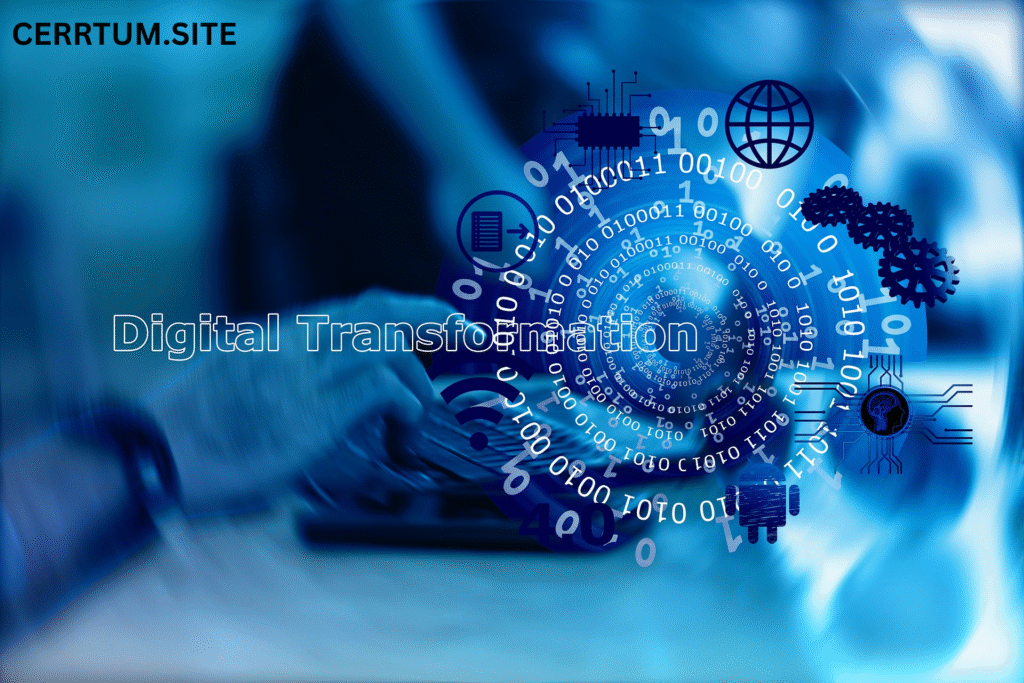
Introduction
Driven by digital technology, the retail sector is changing profoundly. Often referred to as digital transformation, this change involves a whole reinvention of business models, customer experiences, operations, and staff roles rather than merely the acceptance of new technologies or platforms. From supply chain management to customer service, marketing, and sales, digital transformation in retail combines digital technologies with every element of the retail experience. This article investigates the many aspects of digital transformation in retail, its motivating factors, main technologies, effects, difficulties, and future possibilities.
Understanding Digital Transformation in Retail
In retail, digital transformation is the deliberate acceptance and integration of digital technology to drastically alter the operations and value delivery capability of retail companies. Leveraging technologies including artificial intelligence (AI), big data analytics, the Internet of Things (IoT), mobile apps, augmented reality (AR), virtual reality (VR), cloud computing, and omnichannel platforms will help improve customer involvement, streamline operations, and stay competitive in a fast-changing market.
Digital transformation is more general and more strategic than conventional digitalization, which aims at translating analog processes into digital ones. It spans data-driven decision-making, customer-centric innovation, and organizational transformation. Retailers are rethinking their value propositions completely rather than just improving current offerings by means of technology.
Drivers of Digital Transformation in Retail
Several key factors are propelling digital transformation in the retail sector:
-
Changing Consumer Expectations: Today’s consumers demand personalized, seamless, and convenient shopping experiences. They expect real-time product information, smooth online-offline integration, and fast delivery. Retailers must meet these expectations to retain customers and build loyalty.
-
E-commerce Growth: The rise of online retail, led by giants like Amazon and Alibaba, has disrupted traditional brick-and-mortar models. The growth of mobile commerce, social commerce, and voice-assisted shopping has further intensified the need for digital innovation.
-
Technological Advancements: Rapid developments in AI, cloud computing, IoT, and data analytics have made it easier and more cost-effective for retailers to adopt digital solutions and gain deeper insights into consumer behavior.
-
Competitive Pressure: Retailers face stiff competition not only from traditional rivals but also from digitally native companies that use technology to deliver superior customer experiences. To stay competitive, businesses must adapt quickly.
-
Pandemic Acceleration: The COVID-19 pandemic accelerated digital adoption as lockdowns forced retailers to rely heavily on e-commerce, contactless payments, and virtual shopping experiences.
Key Technologies Driving Transformation
Several digital technologies are at the core of the retail transformation:
-
Artificial Intelligence and Machine Learning: AI powers product recommendations, dynamic pricing, inventory optimization, and chatbots. Machine learning algorithms analyze customer data to predict behavior, personalize marketing, and optimize supply chains.
-
Big Data and Analytics: Data is a critical asset for retailers. Analyzing data from multiple sources—web traffic, purchase history, social media—enables businesses to understand customer preferences, forecast demand, and make informed decisions.
-
Internet of Things (IoT): IoT devices, such as smart shelves and RFID tags, improve inventory tracking, automate replenishment, and enhance the in-store experience. Connected devices also enable predictive maintenance and energy efficiency.
-
Cloud Computing: Cloud platforms offer scalable infrastructure for managing data, applications, and customer interactions. Cloud-based solutions support omnichannel retailing, real-time analytics, and collaboration across departments.
-
Augmented and Virtual Reality (AR/VR): AR and VR enhance customer engagement through virtual try-ons, immersive product displays, and interactive shopping experiences. These technologies help bridge the gap between physical and digital retail.
-
Mobile and Contactless Technologies: Mobile apps facilitate shopping, payments, and customer loyalty programs. Contactless payment systems and mobile wallets provide safe, quick, and convenient checkout experiences.
-
Blockchain: Blockchain offers transparency and traceability in supply chains, reducing fraud and increasing trust among consumers. It can also be used for secure digital transactions and loyalty programs.
Digital Transformation Strategies in Retail
Retailers are adopting a variety of digital strategies to enhance customer experience and improve operational efficiency:
-
Omnichannel Retailing: Retailers are integrating online and offline channels to offer a seamless shopping experience. Customers can browse products online, purchase in-store, or use services like click-and-collect and curbside pickup.
-
Personalization: Retailers use data analytics to deliver personalized recommendations, promotions, and content. Personalized marketing boosts engagement and increases conversion rates.
-
Automation and Robotics: Automation in warehouses and stores increases efficiency and reduces labor costs. Robots can handle tasks like picking, packing, and customer service.
-
Digital Supply Chains: Real-time data and AI enable smarter supply chain management. Predictive analytics helps forecast demand, avoid stockouts, and optimize delivery routes.
-
Customer Engagement Tools: Chatbots, mobile apps, and social media platforms enhance customer service and engagement. These tools provide instant support, product information, and updates.
-
Sustainability Initiatives: Digital technologies help retailers track environmental impact, reduce waste, and offer eco-friendly options, aligning with the values of conscious consumers.
Impact on the Retail Ecosystem
Digital transformation has profound impacts across the retail ecosystem:
-
Customer Experience: Customers benefit from personalized, convenient, and engaging shopping experiences. Enhanced service and faster delivery improve satisfaction and loyalty.
-
Operational Efficiency: Automation, data analytics, and real-time monitoring streamline operations, reduce costs, and improve inventory management.
-
Workforce Evolution: Retail employees are taking on new roles that require digital skills. Training and upskilling are necessary to keep pace with technological change.
-
Business Models: Traditional retail models are evolving into platform-based ecosystems. Subscription services, marketplaces, and direct-to-consumer (D2C) channels are gaining popularity.
-
Revenue Growth: Digital transformation opens new revenue streams through online sales, digital advertising, and value-added services.
Challenges in Digital Transformation
Despite its benefits, digital transformation in retail comes with significant challenges:
-
Legacy Systems: Many retailers rely on outdated IT systems that are difficult to integrate with modern digital solutions.
-
Data Security and Privacy: Managing and protecting large volumes of customer data requires robust cybersecurity measures and compliance with regulations like GDPR and CCPA.
-
Change Management: Organizational resistance to change can hinder transformation efforts. Leadership commitment and a clear vision are critical for success.
-
High Costs: Implementing digital solutions can be expensive, especially for small and medium-sized retailers. Budget constraints may limit innovation.
-
Talent Shortage: The demand for digital and analytical skills often exceeds supply. Retailers must invest in training and talent acquisition to bridge the gap.
-
Customer Trust: As retailers collect more data, maintaining customer trust becomes essential. Transparency and ethical data use are key to long-term relationships.
Case Studies of Digital Transformation in Retail
-
Amazon: As a digital-native retailer, Amazon leads in AI, automation, and logistics. Its recommendation engine, Prime membership, and cashier-less Amazon Go stores exemplify digital innovation.
-
Walmart: Walmart has embraced omnichannel strategies, automation, and data analytics. It offers online grocery services, pickup options, and uses robots in its warehouses.
-
Nike: Nike’s D2C strategy includes digital apps like Nike Training Club, a personalized loyalty program, and immersive in-store experiences that blend physical and digital elements.
-
Zara (Inditext): Zara uses data analytics and RFID to optimize inventory and respond quickly to fashion trends. Its stores are integrated with online platforms for a seamless experience.
Future of Digital Transformation in Retail
Hyper-personalization, artificial intelligence-powered decision-making, and immersive digital experiences will define retail going forward. The next stages of retail transformation are predicted to be shaped by trends including voice commerce, metaverse shopping, and subscription commerce. As customers want openness and social responsibility, sustainability and ethical behavior will become even more crucial.
To survive in an ever-changing environment, retailers have to embrace a customer-centric, agile, and data-driven strategy. Essential will be teamwork with technological partners, innovation investment, and lifelong learning.

Conclusion
The digital revolution is fundamentally changing retail. Using digital technology allows stores to improve consumer experiences, streamline processes, and open fresh business prospects. Although old systems, high prices, and skill shortages are issues, the advantages of digital transformation far exceed the hazards. Accepting change, making wise technology investments, and putting the customer first in every decision can help one succeed. Retailers that act aggressively and wisely will lead in the new age of retail as the digital terrain develops.